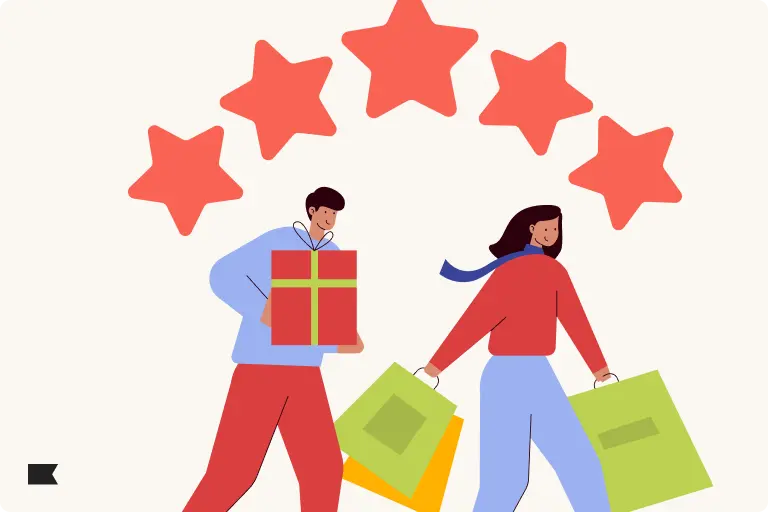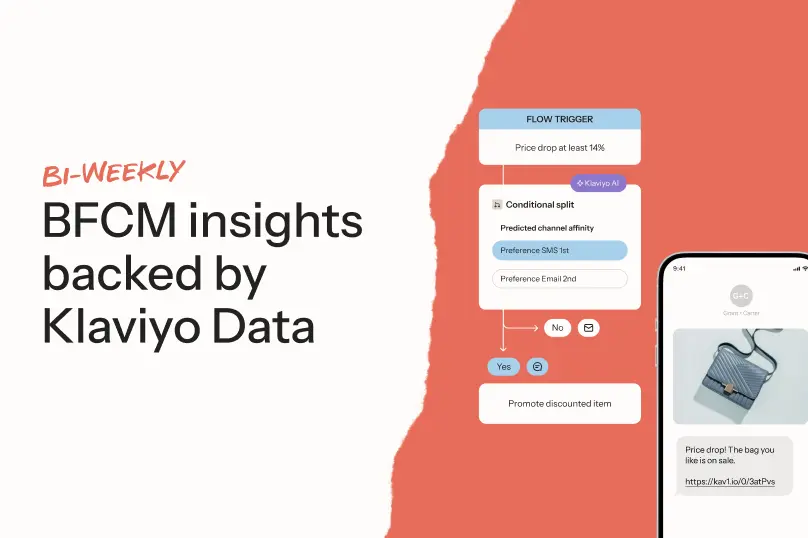Email marketing angles: 80+ proven strategies to boost B2C engagement

Email marketing remains one of the highest-ROI channels for B2C brands, but many marketers fall into the trap of sending the same promotional emails over and over.
While discount-driven campaigns have their place, the most successful brands diversify their email strategy with a rich variety of angles that build relationships, drive engagement, and ultimately increase revenue.
As cofounder of FlowCandy, I know this as well as the next marketer: your customers don’t want to be sold to constantly. They want value, entertainment, education, and genuine connection with your brand. By implementing different email angles—also known as email hooks or themes—you can create a comprehensive email marketing program that keeps subscribers engaged throughout their entire customer journey.
As the only CRM purpose-built for B2C, Klaviyo understands that successful email marketing goes far beyond basic promotional blasts. It’s about creating personalized, timely experiences that resonate with your audience at every touchpoint.
High-impact angles for immediate revenue boost
Promotional campaigns
The classic promotional email remains a powerhouse for revenue generation. These include Black Friday sales, seasonal promotions, buy-one-get-one offers, and product-specific discounts. The key here is timing your promos strategically and not overusing them—aim for quality over quantity.
Best practices:
- Highlight limited availability and time sensitivity to drive more conversions.
- Use value framing and price comparison in templates to drive sales.
- Create compelling calls to action.
- Segment based on purchase behavior.
Product launch campaigns
Every new product deserves a dedicated email campaign—or, better yet, a series of campaigns. Successful brands often send 5–10 different emails around a single product launch, including early access for VIPs, launch day announcements, FAQ emails, and social proof campaigns.
Campaign sequence example:
- Early access for loyal customers
- Launch day announcement
- Product education/how-to content
- Social proof and reviews
- “Last chance” messaging
Limited-edition and collaboration emails
These campaigns create urgency and exclusivity around special releases. Whether they’re announcing a celebrity collaboration or a limited colorway, these emails can drive significant revenue spikes when you execute them properly.
Final hours and last chance emails
Countdown timers and “last chance” messaging create powerful urgency. These work exceptionally well at the end of promotional periods or when inventory is genuinely running low.
Relationship-building angles that pay long-term dividends
Behind-the-scenes content
Show your audience the human side of your brand. This works particularly well for products with craftsmanship stories or brands with compelling origin tales. These emails build emotional connection and brand loyalty.
Customer spotlight campaigns
Feature user-generated content (UGC) that shows real customers using your products. This serves as both social proof and community building. It’s particularly effective for beauty, fitness, and lifestyle brands where you can showcase real results and transformations.
Content-driven emails
Share valuable tips, how-tos, and educational content related to your products or industry. Brands that excel at this create content that doesn’t immediately appear to be interested in sales but keeps the audience deeply engaged.
Team and brand story emails
Introduce your team members, share your brand’s mission, or highlight your company’s milestones. These emails humanize your brand and create deeper connections with your audience.
“The best content doesn’t just promote products. It connects customers to your brand’s mission,” says David Visser, CEO of Zyber and Unlocked, ecommerce growth agencies in New Zealand. “Sharing behind-the-scenes stories or authentic social proof builds that connection.”
“When the same content is repurposed into blogs,” Visser adds, “it does double duty, deepening loyalty while also driving traffic and SEO.”
The best content doesn’t just promote products, it connects customers to your brand’s mission.
Product-focused angles that drive consideration
Product vs. product comparisons
Help customers choose between similar products by highlighting key differences. This works exceptionally well for technical products, backpacks, or any items where customers might be torn between options.
Ingredient or feature spotlights
Deep dive into what makes your products special. This angle works brilliantly for beauty brands, supplements, and any products where ingredients or features are key differentiators.
“Highlighting a product’s unique selling points (USPs) and translating them into how they benefit the end consumer is a power move,” says Anna Sophie Fokdal Christensen, head of email and retention at FABO, a holistic growth partner for ecommerce brands working in the lifestyle and apparel industry.
“Take this example: ‘100% Pima cotton from Portugal’ indirectly says high quality, but does the reader know what Pima cotton is?” Christensen points out. “A better description could be ‘Curated from the softest fabrics—that stay soft.’”
Highlighting a product’s unique selling points and translating them into how they benefit the end consumer is a power move.
Collection and category focus
Instead of featuring individual products, showcase entire collections or categories. This works well for fashion brands, beauty companies, and any retailer with an extensive product catalog.
Engagement and community-building angles
Challenges and contests
Create interactive experiences that get customers more involved with your brand. Think 30-day skincare challenges or UGC contests. These build community and increase engagement beyond just purchasing.
Surveys and feedback requests
Ask your customers what they think. Survey emails have lower immediate revenue impact, but they provide valuable insights for future campaigns and product development. Plus, customers appreciate being heard.
“Surveys are one of the most underrated growth tools,” says Visser. “They make customers feel heard while uncovering data points like attribution source, buying intentions, and preferences, all of which you can feed back into smarter segmentation and higher-converting campaigns.”
Surveys are one of the most underrated growth tools.
FAQ campaigns
Address common questions about your products or brand. These emails serve prospects who are on the fence while also providing value to existing customers. They’re particularly effective for higher-priced items where customers need more information before purchasing.
Social media integration
Drive your email subscribers to follow you on social platforms. While these types of emails are not directly revenue-focused, they create additional touchpoints and community engagement opportunities.
Seasonal and timely angles
Holiday gift guides
Create curated product selections for various holidays and occasions. These emails help customers discover products while solving their gifting dilemmas.
Trending and viral content
If you’re in beauty, fashion, or any trend-driven industry, capitalize on what’s popular. Some brands do this by highlighting products trending on TikTok each week.
New arrivals and monthly highlights
Keep customers informed about what’s new in your store. This works particularly well for brands that frequently launch products or collections.
As seen in press
Turn media coverage into email content. Whenever you get featured in major publications, share that credibility with your email list.
Retention and loyalty angles
Back-in-stock notifications
When popular items return, make sure you let your customers know. You can do this through automated flows, manual campaigns, and even personalized paid ads for high-demand products.
Subscription and loyalty program promotion
If you offer subscriptions or loyalty programs, regularly remind customers of the benefits. This is particularly effective for consumable products where repeat purchases are essential.
Replenishment reminders
Help customers remember when they might need to reorder. This works best for beauty products, supplements, and other consumables with predictable usage patterns.
Win-back campaigns
Re-engage customers who haven’t purchased in a while with special offers or compelling new products. These often provide quick revenue wins, and you can optimize them into automated flows.
Text-based vs. visual emails: the overlooked opportunity
One crucial insight from successful email marketers is the power of text-based emails. These simpler formats often outperform heavily designed emails because they:
- Land in the inbox more reliably
- Feel more personal and authentic
- Are faster and easier to create
- Often achieve better engagement rates
You don’t need a designer or complex coding skills to create effective text-based emails. If you can write a clear, compelling message, you can create successful campaigns.
“Don’t assume designed emails always win,” Visser says. “Text-based emails are faster to create, feel more personal, and can cut through the noise. The key is to A/B test them against visual formats to see what really makes your brand stand out in a crowded inbox.”
Don’t assume designed emails always win.
Segmentation strategies for maximum impact
The effectiveness of any email angle depends heavily on sending it to the right audience. Here are a few ways to segment your list:
- Prospects vs. customers: New subscriber campaigns work differently than loyalty campaigns.
- Engagement levels: Highly engaged subscribers can handle more frequent emails.
- Purchase behavior: Recent buyers might appreciate cross-sells, while lapsed customers need win-back approaches.
- Product interests: Use browsing and purchase data to personalize angle selection.
“The magic happens when the right message meets the right audience,” says Midge Hazelwinkel, head of Klaviyo at Code, a Shopify Plus agency in The Netherlands. “Prospects need education and repeated exposure to your USPs to build trust, while existing customers already know your brand, so retention and loyalty should be the focus.”
“Strategic segmentation ensures every email is relevant, driving higher engagement, more conversions, and stronger long-term relationships,” Hazelwinkel adds. “Without it, even the best content risks being ignored.”
Without strategic segmentation, even the best content risks being ignored.
Implementation tips for B2C marketers
Start by identifying 5–10 angles that resonate with your brand and audience. You don’t need to use all 80+ angles—consistency with a smaller set often works better than sporadic attempts at variety.
Create templates for your chosen angles so you can quickly deploy them when opportunities arise. For example, have a “new press coverage” template ready so you can quickly capitalize on media mentions.
Test different angles with your audience to see what resonates. What works for beauty brands might not work for B2B software, and what works for your competitors might not work for your specific audience.
Consider the customer journey when selecting angles. Welcome series emails should focus on education and relationship-building, while post-purchase emails might emphasize cross-sells and community building.
Measuring success beyond open rates
While opens and clicks matter, we recommend that brands look at longer-term metrics too, like:
- Revenue per recipient
- Customer lifetime value
- Engagement scores
- Subscription and loyalty program sign-ups
- Social media follower growth
Some campaign angles (like those with educational content but not a sales push) might have lower immediate revenue impact but contribute significantly to long-term customer relationships and brand loyalty.
Building your email marketing foundation
With the right tech stack, implementing diverse email angles becomes much more manageable. Klaviyo B2C CRM offers the personalization capabilities, segmentation tools, and analytics you need to execute sophisticated email marketing strategies that go far beyond basic promotional blasts.
The key to email marketing success in 2025 isn’t just having great products. It’s building genuine relationships with your customers through varied, valuable, and well-timed communication.
By expanding beyond promotional emails and embracing the full spectrum of email angles available, you’ll create a more engaging, profitable, and sustainable email marketing program that serves both your business goals and your customers’ needs.

Related content

Learn 5 ways to turn new holiday shoppers into repeat buyers using personalization, seamless returns, targeted outreach, and AI-driven customer experiences.

Learn what to include in your photography style guide to create consistent, on-brand visuals across your B2C marketing channels.

Shopping is about to hit its peak season. But this year’s surge will look different from those before it. Instead of impulsive buying sprees, shoppers are entering the holidays with a more deliberate mindset.